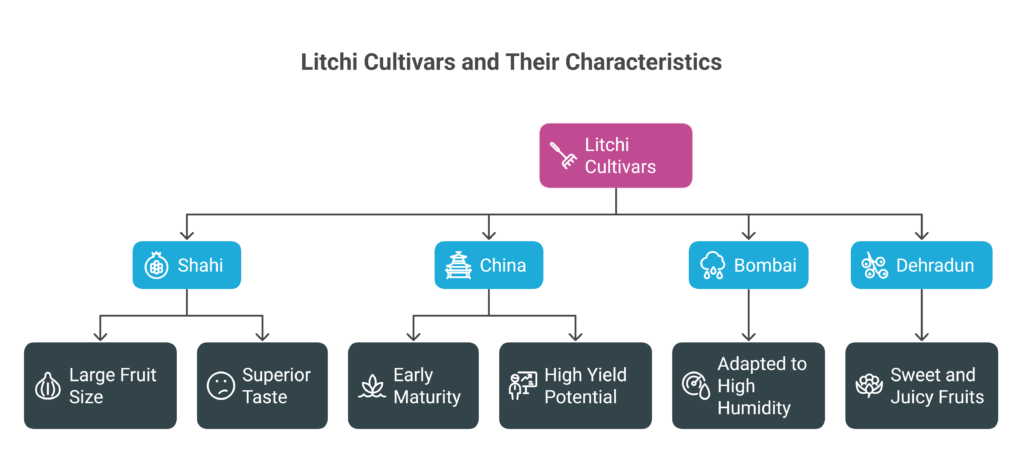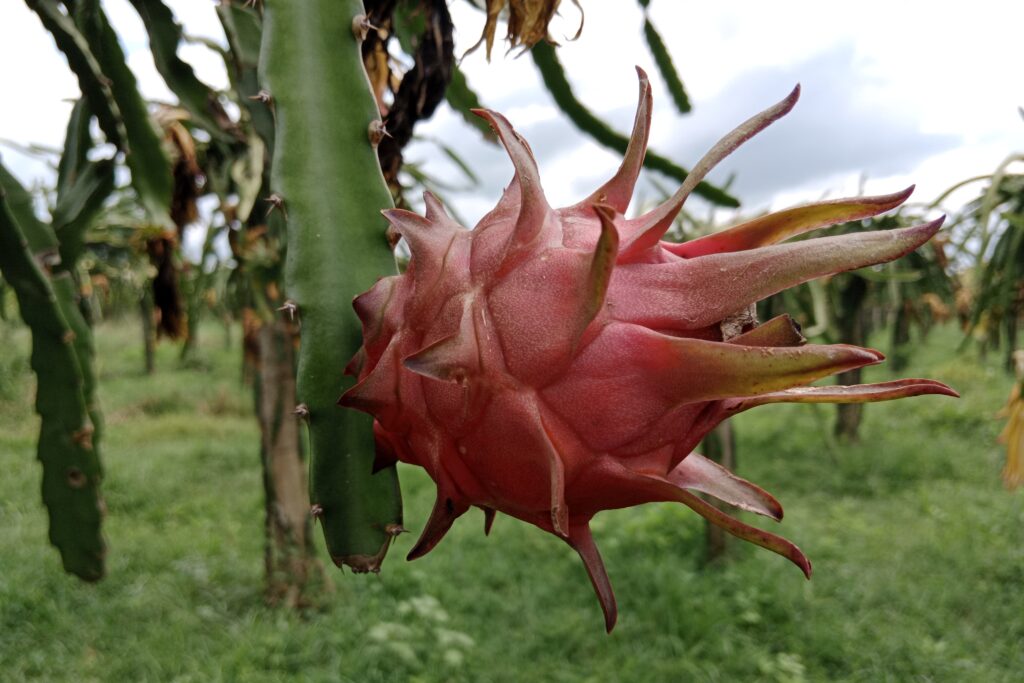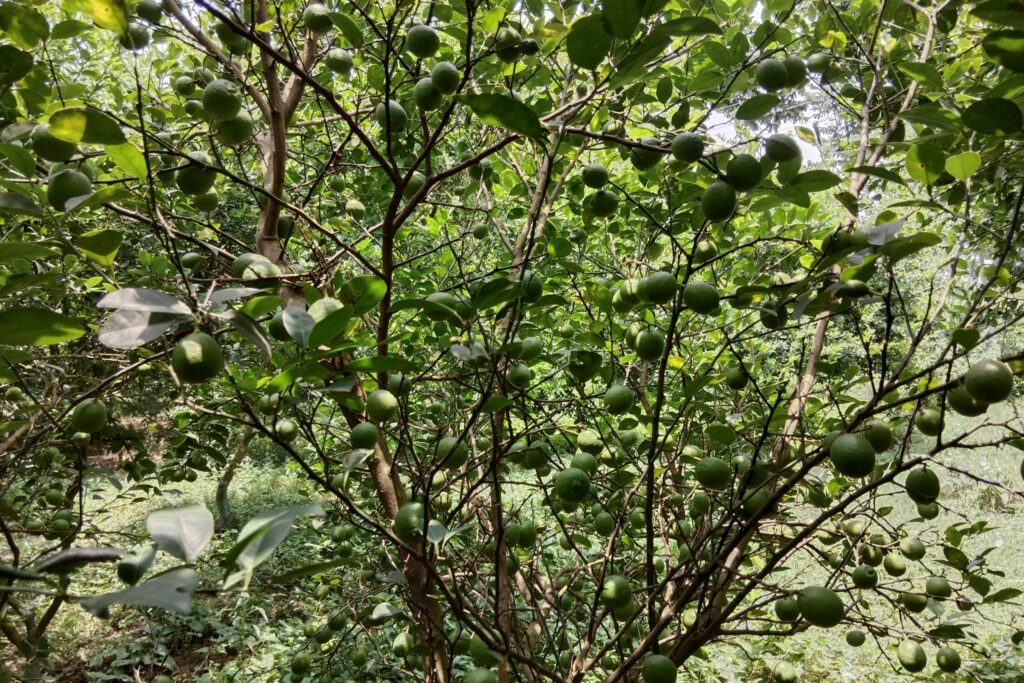Litchi Cultivation
Litchi is a very profitable fruit crop that is widely sought after in both domestic and foreign markets for its sweet, fragrant flavor. Litchi cultivation with the right methods can yield substantial revenues per acre. In addition to providing insightful information on the profitability of this fulfilling agricultural pursuit, this comprehensive guide will take you through each step of litchi cultivation, from clearing the ground to harvesting the fruit.

The Litchi (Litchi chinensis), a plant in the Sapindaceae family, is well known for its superbly juicy and tasty fruit. In India, people frequently eat its edible flesh, or aril, which is transparent and tasty, as a fresh fruit on the table. In China and Japan, however, people tend to favor dried or canned fruit. Litchi is a favorite among customers all over the world because of its distinctive flavor and vivid color, which gives it a special place among fruits.
Land Preparation
Land preparation is the first and most crucial step in litchi cultivation. The soil should be deeply plowed to remove weeds, stones, and other debris, followed by proper leveling to ensure uniform water distribution. Incorporating organic materials such as compost or farmyard manure improves soil fertility and structure, creating an ideal environment for growth.
Before planting, the land must be thoroughly plowed and leveled. Since young litchi plants are sensitive to extreme weather conditions like hot winds and cold temperatures, it is recommended to plant windbreak trees such as silver oak, sesbania, or drumstick along the boundaries of the plantation. Additionally, to protect young plants from frost damage, they can be covered with thatch by late November. These measures help ensure the healthy establishment and growth of litchi plants.
Soil Type for Litchi Cultivation
Litchi thrives deep, fertile soils that drain well and have a pH between 5.0 and 7.0. Alluvial or sandy loam soils are thought to be the best for growing litchi. Avoiding soggy or salty soil is crucial since they can impede root development and reduce production.
Climatic Requirements for Litchi Cultivation
Litchi thrives in subtropical regions with moderate rainfall and high humidity. 20°C to 35°C is the optimal temperature range for its growth. Selecting a site with a favorable microclimate is essential for effective production because cold and high winds can harm the plants.
Major Cultivars
Litchi farming includes several well-known cultivars, each with distinct traits that make them suitable for various growing conditions and preferences. Some of the most prominent varieties are:

a). Shahi
The Shahi variety of litchi is highly prized for its exceptional qualities, particularly its large fruit size and superior taste. Known for its premium quality, this variety has become a favorite among both growers and consumers. Its juicy, aromatic flesh and delightful sweetness make it a standout choice in the litchi market. Growers appreciate Shahi for its high yield potential and market demand, while consumers are drawn to its rich, satisfying flavor. This combination of excellent taste and commercial value solidifies Shahi as one of the most sought-after litchi varieties.
b). China
As an early-maturing variety, the China litchi is recognized for its high yield potential. It is an excellent option for farmers aiming to harvest fruits earlier in the season while ensuring good productivity.
c). Bombai
This cultivar is particularly well-adapted to regions with high humidity. It performs well in such environments and is a dependable choice for areas with consistently high moisture levels.
d). Dehradun
Famous for its sweet and juicy fruits, the Dehradun litchi is a favored variety due to its delightful taste and texture. It is often chosen by those seeking high-quality, flavorful litchis.
Planting
a). Planting Season
The best time to plant litchi is during the monsoon season (June to August) when the soil has adequate moisture.
b). Orchard layout
The double hedge row system is a suitable and cost-effective planting method for ensuring the stability and sustainability of fruit yield while maintaining high-quality fruit in high-density litchi cultivation. This high-density planting approach is designed to maximize productivity and optimize land utilization. In this system, two rows of trees are planted close together, forming a “hedge,” with a wider gap left before the next pair of rows.

c). Spacing Details
- Plant-to-plant spacing (within a row):5 meters
This ensures adequate space for the canopy of each litchi tree to grow without overcrowding.
- Row-to-row spacing within a hedge: 5 meters
The two rows in a hedge are planted 5 meters apart, forming a dense row structure.
- Hedge-to-hedge spacing (between two hedges): 10 meters
The wider space between two hedges allows for proper sunlight penetration, airflow, and ease of farm operations.
d). Pit Preparation
Prepare pits measuring 1m x 1m x 1m in length, width, and depth respectively. Fill these pits with a blend of topsoil, compost, and well-decomposed farmyard manure. A few weeks before planting, dig 1-meter pits at the designated locations. Refill them with a mixture of topsoil, farmyard manure (FYM) (20-25 kg), bonemeal (2 kg), and sulphate of potash (400 g). Once refilled, water the pits immediately to settle the mixture and eliminate any air gaps.
e). Planting Method
Only healthy plants with well-developed roots that are 6 to 9 months old should be chosen for planting, and grafted seedlings are ideal. Make sure the graft union stays above the ground when you place the sapling in the middle of the pit, then cover it with earth. To fit the dirt ball, a tiny hole should be cut in the middle of the pit. It is advised that mycorrhiza be inoculated into the young plants and that the soil not be allowed to dry out entirely after planting. Press the earth gently around the plant, then immediately water it after planting. It is best to attach the plants to a stake for support in places with strong winds.
f). Number of Plants per Acre
In the double-row planting system, around 89 plants can be planted per acre, with the exact number varying based on the spacing between the plants.
Intercropping in Litchi Orchard
Intercropping, the practice of cultivating short-duration crops like vegetables, pulses, or legumes alongside litchi trees, offers numerous advantages, especially during the early stages of litchi cultivation. Since litchi trees take several years to mature and achieve full fruit-bearing capacity, intercropping provides farmers with an additional source of income during this period. Crops such as tomatoes, beans, peas, or leafy greens can be grown between the rows of litchi trees, making efficient use of the available space.
Additionally, intercropping helps control weeds by covering the soil and suppressing unwanted plant growth. Leguminous crops, in particular, enrich the soil by fixing atmospheric nitrogen, reducing the need for chemical fertilizers. This practice not only optimizes land use but also promotes sustainable farming by enhancing soil health. In essence, intercropping is a strategic and eco-friendly method to boost both profitability and sustainability in litchi orchards during their initial growth phases.
Intercropping in Summer & Kharif Season
Vegetables: Pumpkin, cucumber, ridge gourd, bitter gourd
Leguminous Crops: Moong, cowpea, etc.
Green Manure Crops: Sunnhemp, dhaincha
Intercropping in Winter Season
Vegetables: Radish, beet, turnip, cauliflower, peas, beans
Leguminous Crops: Gram, etc.
Spices: Turmeric
Irrigation in Litchi Plants
Litchi cultivation need frequent irrigation to grow and develop properly, particularly when they are flowering and fruiting. It is strongly advised since drip irrigation helps save water and guarantees precise fertilizer delivery to the roots. Waterlogging must be avoided since excessive soil water retention can harm plants and result in root rot. Effective irrigation management is essential to the general health of litchi plants and the maintenance of optimal soil moisture.
| Growth Stage | Description | Water Requirement |
| Planting to Establishment (1–3 years) | Young litchi plants require frequent but light irrigation to establish a strong root system. | 15-25 liters per plant per day |
| Vegetative Growth Stage (4–6 years) | Trees require more water to support canopy development. | 25–40 liters per plant per day |
| Flowering and Fruit Development Stage | Critical stage where water stress can lead to flower drop and poor fruit set. | 40-60 liters per plant per day |
| Mature Trees (7+ years) | Mature litchi trees require deep irrigation to support fruit production. | 40–60 liters per plant per day |
Fertilizer and Manure for Litchi Cultivation
Manure and Fertilizer Application for Litchi
Proper application of manure and fertilizers is essential for the healthy growth and productivity of litchi plants. The quantity of manure and fertilizers varies depending on the age of the plant. Below is a detailed guide for manure and fertilizer application per plant per year:
Fertilizer Application Schedule for Litchi
| Age of Plant (Years) | Farmyard Manure (FYM) (kg/plant/year) | Calcium Ammonium Nitrate (kg/plant/year) | Super Phosphate (kg/plant/year) | Muriate of Potash (MOP) (kg/plant/year) |
| 1–3 | 10–20 | 0.3–1.0 | 0.2–0.6 | 0.05–0.15 |
| 4–6 | 25–40 | 1.0–2.0 | 0.75–1.25 | 0.20–0.30 |
| 7–10 | 40–50 | 2.0–3.0 | 1.50–2.0 | 0.35–0.45 |
| Above 10 | 60 | 3.5 | 2.25 | 0.60 |
Key Recommendations for Fertilizer Application
Proper fertilizer application is critical for the healthy growth, flowering, and fruiting of litchi plants. Below are the key recommendations to ensure effective nutrient management:
1. Time of Application
Apply the above-mentioned fertilizers in three equal split doses during the month of March, June and October for better growth and yield of litchi.
a). First Dose (March)
The first dose of fertilizer is applied at the beginning of spring, typically in March, to stimulate new vegetative growth and prepare the litchi plants for the upcoming flowering phase. This timely application ensures the trees receive essential nutrients to support healthy development and robust growth during the active growing season.
b). Second Dose (June)
The second dose of fertilizer is applied in June, during the fruit development stage, to provide the necessary nutrients for optimal fruit enlargement and quality. This application ensures the litchi trees receive adequate nourishment to produce healthy, well-sized fruits with excellent flavor and texture.
c). Third Dose (October)
The third fertilizer dose is applied to the tree after harvest, which typically occurs in October, to replenish soil nutrients, revitalize the tree, and prepare it for the upcoming growing season. This spray helps the litchi plants recover from the fruiting period and build up their strength for the next growth cycle.
Give the plants lots of water as soon as the fertilizer is given to ensure proper nitrogen uptake. Additionally, avoid overwatering, which can lead to nutrient leaching and waterlogging—two problems to which litchi plants are particularly susceptible. Maintaining consistent soil moisture levels is essential for fostering healthy growth and maximizing fruit yield, especially during critical growth stages like flowering and fruit development.
Weed Control
Effective weed control is vital in litchi cultivation to ensure trees access nutrients, water, and sunlight without competition. Weeds can hinder growth and reduce yields, so regular removal is necessary.
Mulching with organic materials like straw or dried leaves suppresses weeds by blocking sunlight and preventing germination. It also conserves soil moisture, regulates temperature, and improves soil quality as it decomposes.
For larger orchards, mechanical weeding or approved herbicides can be used cautiously. Combining manual weeding with mulching promotes a healthy environment, boosting litchi growth and productivity.
Pest and Disease Management
Pests in Litchi Cultivation and Management Strategies
a). Litchi Mites

A significant pest in litchi cultivation, mites cause damage as both adults and nymphs feed on the sap from the undersides of leaves, shoots, and other plant parts. Infested leaves turn from yellow to a grayish-yellow hue, eventually curling, twisting, and falling off.
To manage this issue, remove and dispose of the affected plant parts. Apply chemical treatments such as Imidacloprid 17.8EC@1ml/Ltr or Propargite 57EC @ 2.5 ml /ltr mixed with water, spraying twice at intervals of seven days. Ensure the pesticides are applied to young shoots and before panicle emerges for effective control.
b). Fruit Borer
This pest feeds on the fruit pulp, damaging the fruits and rendering them unsuitable for human consumption. Infested fruits often show small pinhead-sized holes.
To manage this issue, maintain a clean orchard and remove or destroy affected and fallen fruits away from the field. Release Trichogramma @ 20,000 eggs per acre as a biological control measure. Apply a combined spray of Nimbicidine@50gm/10Ltr of water + Cypermethrin 25EC@8ml/10Ltr + Dichlorvos@20ml/10Ltr at the fruit set and color development stages. Repeat the spray at 7-day intervals. Additionally, spraying Diflubenzuron 25WP@2gm/Ltr of water during the fruit development stage is effective. Ensure the last spray is applied at least 15 days before harvest.
c). Leaf Miner
If an infestation is detected, promptly remove the affected leaves.
During the new flush development stage, apply a spray of Dimethoate 30EC @200ml/150Ltr or Imidacloprid 17.8SL@60ml/150Ltr. Follow up with a second spray after an interval of 15 days for effective control.
Diseases in Litchi Cultivation and Management Strategies
a). Anthracnose
Irregular, deep chocolate-colored spots appear on leaves, branches, flowers, and fruits.
To manage this, perform pruning to avoid overcrowding of branches. As a preventive measure, spray Bordeaux mixture in February, April, and October, or apply Captan WP@0.2% during these periods.
b). Downy mildew
This disease, also known as brown blight, is characterized by brown lesions accompanied by white powdery growth on leaves, flowers, and immature fruits. It can also affect ripe fruits. The spread of this disease is primarily caused by higher daytime temperatures, lower nighttime temperatures, high humidity, and continuous rainfall.
To manage the disease, ensure proper orchard hygiene after harvesting. During winter, apply a spray of copper oxychloride, and in spring, use Copper sulphate to control and prevent the spread of the disease.
c). Red Rust
Small dark algae patches appear on the lower side of leaves, spreading rapidly and eventually developing a velvet-like reddish-brown to orange growth. Affected leaves often show curling.
As a preventive measure, spray Copper Oxychloride@0.3% in June and October. If infestation is observed in the field, apply Bordeaux Mixture during September-October and February-March. Depending on the severity, repeat the spray at 15-day intervals for effective control.
d). Fruit Rot
This is a serious post-harvest disease of litchi. Improper storage conditions lead to the development of large water-soaked lesions on the fruits, which later emit a fermented odor.
To prevent this, the store harvested fruits at low temperatures, as cooler conditions significantly slow down the rate of rotting.
Harvesting
Litchi fruits are ready for harvest 90–120 days after flowering, depending on the cultivar. Harvest the fruits when they turn pink or red and have a sweet aroma. Use clippers to avoid damaging the branches.


